{{ post.title }}
{{ post.excerpt }}
Read full storyYou can find our TOEFL Speaking Lesson Series in our lesson library. Like all our ESL Lesson Content, these lessons are designed to be teacher-led. That is, they are designed to be taught in a live setting, by a teacher. Each of these teacher-led lessons comes with an attached homework activity to reinforce the live lesson.
If you are coaching TOEFL candidates, our TOEFL lessons will be a valuable tool to add to your practice. If you’ve always wanted to coach TOEFL candidates yet didn’t know where to start, you’ve come to the right place!
To celebrate this release, we held a teacher-training webinar to introduce the main concepts you need to know about the Speaking Section of the TOEFL test.
The following is a summary of each lesson that you’ll find in our new TOEFL Speaking series!
We look at the main question types that you’ll find on the Speaking Section of the test. We also take a look at the criteria that is used to score each answer.
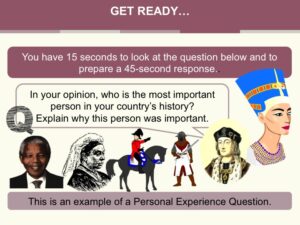
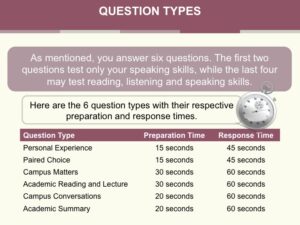
The Personal Experience Question features first on the test. It is the first of two independent questions, meaning that it requires no further reading or listening activity to answer the question. With a few transition and linking words, and a template to put into place, these questions should be a confident start for a candidate.
Paired Choice Questions require the candidate to choose between two things or ideas, and to explain his or her preference. Some students find these a little challenging, though the only way to answer them effectively is to pick a side, and run with it!
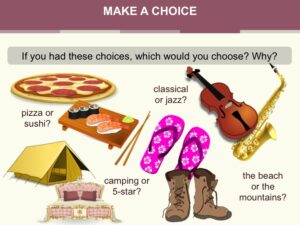

The Campus Matters Questions are the first integrated question on the test. The candidate reads a short text and hears a conversation between two people, about a non-academic matter. The conversation could be about the campus library, cafeteria or even housing! The candidate must summarize both the reading and the students’ opinions on it.
In Academic and Reading Lecture Questions, the candidate must look for relationships between ideas expressed in a written text and a listening passage. We introduce a template and strategy for undertaking these questions.
TOEFL tests your ability to understand language related to life on campus. There is a specific focus on issues that affect academic performance. We explore this question type in detail and provide your students with a template.
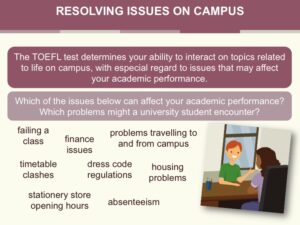
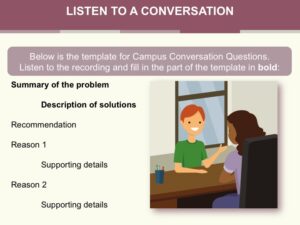
In Academic Summary Questions, students answer questions based on a recorded excerpt of a sample lecture. These questions invariably touch on specific subject matters but the focus is on identifying the relationships between main ideas and the supporting details.
All lessons in this category have sound recordings, so make sure you and your student are set up accordingly with headphones!
Finally, for the first time, Off2Class has incorporated recording functionality into Homework Activities. Students can now send you recordings of their responses to the sample TOEFL questions. We think this addition will keep students motivated as they head toward their TOEFL test date.
6 Comments
Nydia Garcia says:
August 15, 2017 at 12:54 pm
Hi! 1-How long does the TOEFL course is? I mean in how many classes does the teacher-student cover the TOEFL content?
2- How many excersices or examples does the TOEFL platform has for each section?
Thanks
James Heywood (Off2Class) says:
August 15, 2017 at 6:22 pm
Hi Nydia,
That’s a challenging question to answer because there are so many variables.
The best I can offer is this. If the student possesses at least at a strong B2 or C1 CEFR proficiency level, and has not taken the test previously, then I estimate 35 one-hour lessons to cover the format, structure and questions types of all skills in the test – Reading, Speaking, Writing and Reading. This figure does not account for lessons that may be required for General English grammar and vocabulary that might require further teaching. With most TOEFL students, there will be at least one area of weakness, such a phrasal verbs, transition and linking words, passive structures, etc., that would add the the 35 hours mentioned.
Regards,
James
PETER REID says:
August 15, 2017 at 5:47 pm
Hello James, unfortunately, I missed the webinar as I had to work so I am watching this as an after the fact webinar.
I am just going to make a comment that the sound is really bad, there is a lot of echo which makes it really difficult to understand what you are saying, also it makes it hard to want to keep on listening.
James Heywood (Off2Class) says:
August 15, 2017 at 6:27 pm
Hi Peter,
Thanks for your comment.
Unfortunately my state-of-the-art microphone had a hiccup before the webinar so I had to use the laptop’s built-in microphone. The sound quality is the best I could make it – the following webinars will undoubtedly have a clearer audio track.
Regards,
James
Roy says:
August 15, 2017 at 10:45 pm
Hey James,
I was perplexed and really couldn’t understand why your audio sounded so painful as it did. I was wondering if the audio just didn’t record well during your session. So, I was just going to suggest that perhaps you may want to record your audio on a seperate track and then try syncing it up. At least, it’s a good lesson for people teaching online that it’s important to purchase a good quality microphone so that you sound pleasent.
Thanks for the session!
James Heywood (Off2Class) says:
August 16, 2017 at 12:36 pm
Hi Roy,
Thanks for stopping by.
This morning I reviewed my edited files and realized that I had created the echo and reverb effect inadvertently. The webinar has been reloaded and the audio track is now satisfactory.
James